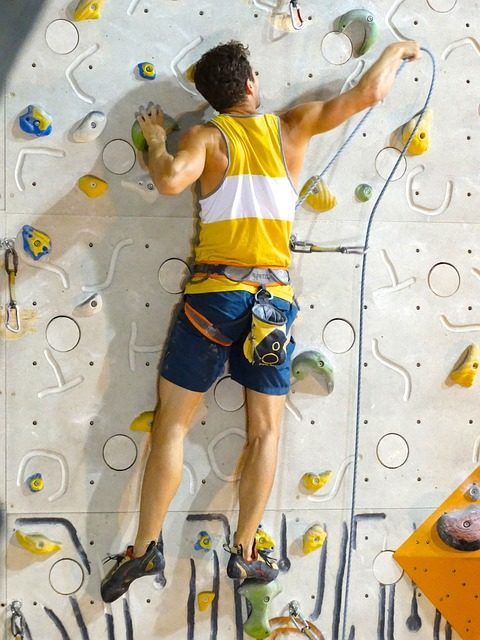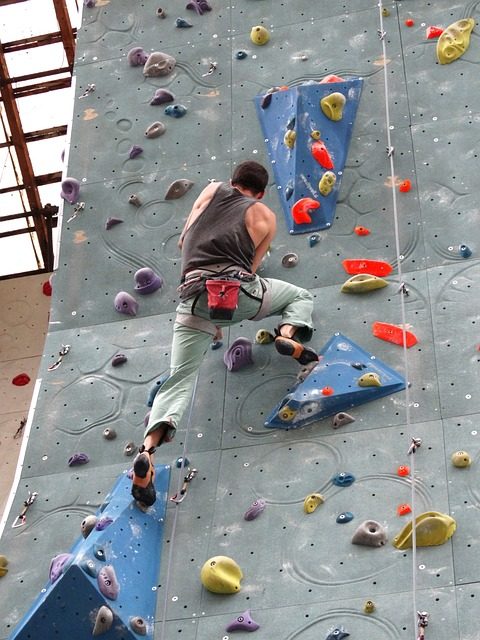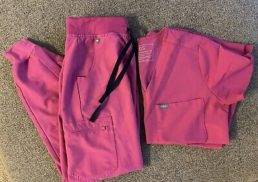Ready to embark on an amazing rock climbing journey but unsure where to start with choosing the right climbing shoes? Fear not, we’ve got you covered! In this comprehensive guide, we’ll walk you through the ins and outs of climbing shoes, from understanding the different types, materials, and closure systems to finding the perfect fit for your feet. So, let’s get started and unleash your inner climber with the perfect climbing shoe!
Table of Contents
Key Takeaways
Get the right shoes for your climbing style and skill level.
Consider materials, construction, closure systems & fit when buying a pair of climbing shoes.
Look out for established & up-and-coming brands to get the best performance from your shoe!
Climbing Shoe Essentials

Entering the world of climbing, you’ll soon discover the significance of having the right pair of climbing shoes for a comfortable and enjoyable experience on the rock. Your specific climbing style will determine the performance and suitability of the type, material, and closure systems of your climbing shoes.
Types of Climbing Shoes
Different types of climbing shoes cater to various climbing styles and skill levels. From flat, downturned, stiff, and soft shoes, each type serves a specific purpose in the world of climbing.
Flat-lasted shoes, also known as flatter shoes, are designed for all-day wear, making them a popular choice for beginners and multi-pitch climbers. Asymmetrical or aggressive shoes, on the other hand, have a more downturned shape and skew inwards to provide more power and pressure through your big toe. These downturned shoes are perfect for tackling overhanging climbs and indoor climbing, where steep routes are common.
Some shoes, like Butora Acro and Scarpa Drago, even have rubber designed specifically for toe hooking and heel hook, catering to a unique climbing style. Identifying the type of climbing you’ll be doing is an important step towards finding the best matching pair of shoes for your needs.
Material and Construction
The material and construction of climbing shoes can significantly impact their shoe’s performance, durability, and comfort. You’ll find options like leather, synthetic, and lined or unlined shoes in the market, which may feel different from your regular street shoes.
For instance, gaps between your toes in climbing shoes can decrease sensitivity, so it’s important to choose the right size, which could be different from your street shoe size. Shoes like the La Sportiva TC Pro feature a stiff P3 midsole, providing a solid base for jamming your feet and good support for those tiny edges.
Considering how the material will stretch over time is an important aspect when choosing your climbing shoes. Leather shoes are more likely to stretch compared to synthetic shoes. This is due to the differences in material composition. Understanding these details will help you make an informed decision about your climbing shoe purchase.
Closure Systems
Closure systems, including laces, Velcro, and slippers, impact the fit, adjustability, and ease of use of your climbing shoes. Each closure system offers its own set of advantages and disadvantages, affecting your shoe’s performance and climbing experience.
Laces allow you to adjust the fit of your shoe, providing a more customized and secure fit. However, they can be time-consuming to put on and take off and may not be the best choice for toe-hooking.
Velcro straps, on the other hand, offer a more supportive and adjustable fit than slippers and are easier to get on and off than lace-up shoes. The downside is that the straps can sometimes get in the way when toe-hooking.
Slipper-style climbing shoes are easy to slip on and off, making them a popular choice for bouldering and gym climbing. However, they may not provide as much support as laces or Velcro, which could affect your climbing performance.
A thorough understanding of each closure system’s pros and cons will guide you in finding the ideal pair of climbing shoes that meet your needs.
Finding Your Perfect Fit

Both comfort and performance rely heavily on finding the perfect fit for your climbing shoes. A well-fitting shoe will ensure stability, sensitivity, and proper foot support, allowing you to focus on your climbing rather than discomfort. Sizing down one or two sizes from your regular shoe size is typically recommended for your first pair of climbing shoes.
For beginners, achieving a snug yet comfortable fit is pivotal, with your big toe reaching the end of the toe box without excessive curling. Keep in mind that climbing shoe sizes can be different from your regular shoe sizes, so trying on various sizes and considering your foot shape is key to finding the right fit.
Sizing Tips
As sizing can greatly vary between brands and models, trying on climbing shoes before purchasing is vital to find the right fit. Considering the shape and profile of your toes is important when selecting a shoe that offers both comfort and performance. Different shoe models are better suited for different foot shapes, so paying attention to the shape of your foot is vital.
In terms of material stretch, leather uppers generally have more give than synthetic ones. Leather climbing shoes can stretch up to half a size, while synthetic shoes stretch hardly at all. Taking this into account when selecting your climbing shoes will help you find the perfect fit that remains comfortable and performs well over time.
Remember that the ultimate goal is to find a pair of climbing shoes that provide a snug, secure fit without causing pain or discomfort. Taking the time to try on different sizes and styles, considering your foot shape, and accounting for material stretch will help you find the best climbing shoes for your needs.
Importance of a Snug Fit
For optimal performance, a snug fit in climbing shoes is necessary to ensure stability, sensitivity, and proper foot support. A well-fitting shoe allows you to feel the smallest footholds and gives you better control on the wall. It’s a balance of comfort and performance that should not be overlooked.
Your foot should remain relatively still when stepping on small footholds while wearing climbing shoes. This is crucial for maintaining balance and stability while climbing. A snug fit ensures that your shoe is in contact with as much of your foot as possible, offering the best support and control during your climb.
Remember, the goal is to find a pair of climbing shoes that provide a snug, secure fit without causing pain or discomfort. Taking the time to try on different sizes and styles, considering your foot shape, and accounting for material stretch will help you find the best climbing shoes for your needs.
Top Climbing Shoe Recommendations
Whether you’re a beginner, intermediate, or advanced climber, there are climbing shoes designed to cater to your specific needs, skill level, and climbing style. In this section, we’ll give you our top recommendations for each skill level, providing options for various climbing styles and terrains.
Best Shoes for Beginners
Beginner-friendly rock climbing shoes prioritize comfort, durability, and versatility, making them ideal for those just starting their climbing journey. The La Sportiva Tarantulace and Black Diamond Momentum are two excellent options for new climbers.
The La Sportiva Tarantulace features:
Unlined leather upper
Mildly asymmetric shape
Stiff last
Thick soles (5mm of FriXion rubber)
This combination of features makes them comfortable and supportive, perfect for building confidence on the rock.
The Black Diamond Momentum offers a flat profile, moderate asymmetry, and 4.3 mm of rubber for durability and grip. These shoes provide a comfortable fit with the right amount of support for those new to climbing, ensuring a positive experience as you begin your climbing journey.
Top Picks for Intermediate Climbers
Intermediate climbers can benefit from shoes like the La Sportiva Muira VS and Scarpa Quantic, offering a balance of performance and comfort. These shoes are designed to cater to the evolving needs of climbers as they progress in skill and take on more challenging climbs.
The La Sportiva Muira VS features:
P3 midsole
Asymmetric and downturned last
Dentex lining (no lining underfoot)
Leather upper
4mm Vibram XS Grip2 rubber
The three Velcro straps that attach oppositely provide a precise and secure fit, making them ideal for intermediate climbers looking for a performance-oriented shoe.
The Scarpa Quantic climbing shoe:
Designed by the legendary Heinz Mariacher
Versatile all-around shoe
Offers a balance of comfort and performance
Suitable for a wide range of climbing styles and terrains
Great option for climbers transitioning from beginner to intermediate skill levels
High-Performance Shoes for Advanced Climbers
Advanced climbers can opt for high-performance shoes like the La Sportiva Solution Comp and Scarpa Drago, designed specifically for challenging terrains and specific climbing disciplines, such as sport climbing. These shoes offer the precision, control, and sensitivity required for tackling difficult climbs.
The La Sportiva Solution Comp features:
Softer and more sensitive design than the original Solution
Extra rubber coverage on the toe for better precision on tiny holds
Traditional, tapered heel for excellent toe hooks and foot jams
Exceptional heel-toe camming performance
The Scarpa Drago is known for its extreme softness and sensitivity, allowing advanced climbers to feel every bump and divot on the rock. Its great ventilation ensures that your feet won’t get too hot and sweaty compared to other high-performance shoes. The Drago is perfect for climbers looking for a comfortable yet performance-driven shoe.
Caring for Your Climbing Shoes
Proper care for your climbing shoes prolongs their lifespan and maintains their performance. Breaking in, stretching, cleaning, and deodorizing your shoes are all key aspects of proper care.
By taking the time to maintain your shoes, you’ll get the most out of your investment and enjoy a better climbing experience.
Breaking In and Stretching
Wearing your climbing shoes for extended periods allows for breaking in and stretching, ensuring a comfortable and secure fit. Initially, your shoes may feel tight and uncomfortable, but over time, they will adjust to the shape of your feet and provide the optimal fit for climbing performance.
There are a few ways to speed up the breaking-in process, such as wearing your shoes with socks or soaking them in hot water. Typically, it takes 3-5 climbing sessions to break in new climbing shoes, but it could take longer depending on how often and intensely you’re climbing.
Remember that failing to break in your climbing shoes can lead to blisters, calluses, and even nail bed infections. It’s essential to invest the time in breaking in your shoes to ensure a comfortable fit and prevent potential injuries during your climbs.
Cleaning and Deodorizing
Maintaining the longevity and performance of your climbing shoes requires regular cleaning and deodorizing. Preventing odor and deterioration not only keeps your shoes in top condition but also ensures a more enjoyable climbing experience.
To clean your climbing shoes, follow these steps:
Use a soft brush and some water with mild soap, or opt for a cold water hand wash.
Avoid using harsh chemicals, washing machines, and direct sunlight, as these can damage your shoes.
Baking soda is a great option for removing odors, keeping your shoes smelling fresh.
It’s a good idea to clean your climbing shoes every couple of months, depending on how often you’re climbing. By keeping your shoes clean and odor-free, you’ll not only prolong their lifespan but also maintain their performance on the rock.
Climbing Shoe Accessories and Extras
Climbing shoe accessories and extras, such as socks and resoling services, can enhance comfort and extend the life of your shoes. These additional elements allow you to tailor your climbing experience to your personal preferences and get the most out of your climbing shoes.
Socks or No Socks?
Deciding whether to wear socks with your climbing shoes boils down to personal preference, fit, and desired performance. Some climbers argue that wearing socks can increase comfort and reduce the risk of blisters and foot injuries, while most climbers choose not to wear socks for a snugger fit, better sensitivity, and improved precision while climbing.
The pros of wearing socks with climbing shoes include filling out a larger shoe, better hygiene (especially with rental shoes), and less smell. However, the cons include decreased sensitivity and accuracy due to the extra fabric. Ultimately, the decision to wear socks with climbing shoes comes down to your personal preference and what feels best for you.
In the end, it’s up to you whether you want to wear socks or not with climbing shoes. Consider your climbing style, the fit of your shoes, and how you want to perform on the rock to make the best choice for your needs.
Resoling Services
Resoling services offer a cost-effective alternative to buying new shoes and can help extend the life of your climbing shoes. By replacing the worn-out soles with new ones, you can maintain the performance and durability of your shoes, allowing you to continue climbing without the need for a new pair.
Shoe resoling involves removing the old sole and adding a new one to restore your shoes to peak performance. This process can be done multiple times, depending on the damage and wear of your shoes. Resoling costs typically range from $15 to $100, depending on the service and the complexity of the repair.
Investing in resoling services not only extends the life of your climbing shoes but also helps reduce waste and save money in the long run. By taking care of your shoes and opting for resoling when needed, you’ll get the most out of your investment and continue to enjoy your climbing adventures.
Climbing Shoe Brands to Watch
Both established and up-and-coming climbing shoe brands provide a variety of choices for all skill levels and preferences and are worth keeping an eye on. These brands are continuously innovating and evolving to cater to the needs of climbers, providing options that suit various climbing styles and terrains.
Established Brands
Established brands like La Sportiva, Scarpa, and Five Ten provide reliable, high-quality climbing shoes for various climbing styles and skill levels. These brands have a long history of producing top-notch climbing gear and are trusted by climbers worldwide for their performance and durability.
La Sportiva is well known for its technical and innovative designs, offering a wide range of climbing shoes that suit different styles and preferences. Scarpa, another powerhouse in the climbing shoe industry, offers various models designed for different terrains and skill levels. Five Ten, with its top-quality rubber and US-based manufacturing, ensures that their shoes meet the highest performance standards.
These established brands have proven themselves as leaders in the climbing shoe industry, consistently delivering products that cater to the ever-changing needs of climbers. Whether you’re a beginner or an experienced climber, you can trust these brands for their commitment to quality, performance, and innovation:
La Sportiva
Scarpa
Five Ten
Evolv
Black Diamond
Up-and-Coming Brands
Up-and-coming brands like Butora and Tenaya offer innovative designs and features that cater to the evolving needs of climbers. These brands are gaining traction in the climbing shoe industry, providing fresh and unique options for climbers seeking something different from established brands.
Butora climbing shoes, for example, are known for their excellent grip, durability, and comfort. They offer various designs to suit different foot shapes and sizes, ensuring a comfortable and secure fit for all climbers. Tenaya, another rising star in the climbing shoe industry, focuses on response, precision, and comfort in their designs, producing high-quality, performance-oriented climbing shoes.
These up-and-coming brands are worth keeping an eye on, as they continue to push the boundaries of climbing shoe design and technology. With their innovative offerings and commitment to meeting the needs of climbers, these brands are poised to make a significant impact on the climbing shoe market:
Brand A
Brand B
Brand C
Brand D
Brand E
Summary
In conclusion, understanding the essentials of climbing shoes, finding the perfect fit, and caring for your shoes are crucial aspects of your climbing journey. Whether you’re just starting or an experienced climber, there’s a climbing shoe out there designed to cater to your unique needs and preferences. With the help of this guide, you’ll be better equipped to unleash your inner climber and conquer the rock with confidence. Happy climbing!
Frequently Asked Questions
What is so special about climbing shoes?
Climbing shoes are designed to provide precise, form-fitting support to the foot, allowing climbers to feel and control footholds of all sizes. Most forgo socks to achieve a more comfortable fit, providing an ideal balance point on the foot.
Do climbing shoes really make a difference?
Climbing shoes really make a difference, especially for lower grade climbers. Stiffer shoes provide extra support when standing on smaller holds, while softer shoes are better for smearing. Experienced climbers may not need specialized footwear, but the right shoes can be a huge help for those working their way up.
Are bouldering shoes different from climbing shoes?
Bouldering shoes are highly asymmetrical, with a snug fit, a tight heel cup and a soft midsole that provide great grip when feeling the terrain. On the other hand, climbing shoes generally have less asymmetry and are less aggressive, although this may still be included in some descriptions.
What are the main types of climbing shoes?
Climbing shoes come in a variety of styles, including flat, downturned, stiff, and soft, each designed to suit different climbing abilities.
How do I find the right size for my climbing shoes?
Try on different sizes and styles to find the best fit, taking into account your foot shape and the fact that climbing shoe materials will stretch.









